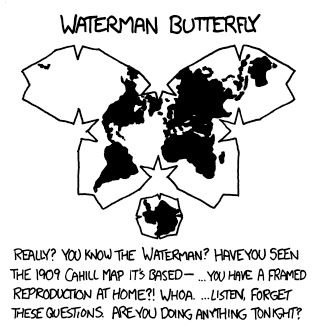How? How did we let this happen?
Not only are there all these types but sometimes the same type has reversed polarity of pins such as the type I in your link.
Can we just start again?
Power socket type variance is just a symptom of the underlying issue of historic networks whose requirements were or are adjusted to the given conditions of electric power generation, transport or consumption.
We have different operating frequencies here in Japan depending upon which part you’re in. Some is 50hz some is 60hz.
Are devices generally interoperable?
These days, yes. Older devices were usually only made for one frequency or the other. Clocks, for example, would not keep time correctly if they were using the cycles as a way to count time and were used in the opposite area for which they were designed.
How did we let this happen?
How could we not have done? When electricity was first being proposed of a way of powering homes and industry we couldn’t even agree on a standard for distribution (Tesla vs Edison). The world’s governments didn’t step in because this was a dispute between private companies. Just like governments didn’t decide whether we should use VHS vs Betamax, or drink Coke vs Pepsi.
And then once a country decided on a standard distribution method they had to pick a voltage, a frequency, and a plug/socket design. Again, there was no real reason for governments to get heavily involved at this point - after all, nobody knew if this new-fangled electricity thing would ever really catch on.
Can we just start again?
Sure. But it will cost maybe hundreds of billions. Maybe more than that. It doesn’t matter which plug/socket design you say is the right one for the whole world, most of the world won’t already be using it (just look at the map!). So all those countries are going to have to change not only the plug on every single appliance in existence in their country, but also every single socket on every wall in every building. And what’s the benefit to the countries that have spent al those billions doing that? Absolutely nothing - the advantage and profits will be reaped by product manufacturers who don’t have to produce a variety of connectors.
Slowly starting to see usb ports become more common on wall outlets. The spec currently maxes usb c to 5 amps, but, maybe some day…
Isn’t it also that the plug matches the voltage and frequency of the grid? It keeps you from frying your thing because you can’t plug in the wrong device in the wrong grid, you need an adaptor thingy?
But even with an adapter you risk an electrical fire or blowing up the device. You need an active step up or step down converter. My mum always buys cheap electrical stuff from SE Asia off eBay. She gave us a kitchen appliance like that, it’s rated for 110v and doesn’t have a switching power supply. Even using the supplied adapter we’d be smashing it with 240v from the wall. So it went on the trash heap. A step down converter is ridiculously impractical to use around the house.
One of the reasons for it is contraband, imports and local industries. If as a government, I want to impulse local industry and hurt contrabands, getting an electric socket exclusive for my country, that local regulations enforce, is an easy measure to use.
I went to South Africa last year, they have the bulkiest, most awkward plugs I’ve ever seen
Yeah they look like you can plug in a full warehouse of dryers into just one of em. Lost potential
Don’t though, the power grid down there is already beyond capacity
I’ve never seen any in China that are different to the ones in Australia. Are these used or standards?
In China they have a US/EU/AUS Mix socket. Probably because of all the different products for different markets produced there
The Chinese plugs that look similar to Australia plugs are different in at least two ways
-
Chinese pins are thinner which means they don’t seat well in Australia
-
Australian plugs must have partially insulated pins
-
This is not a map, it’s missing a title.







